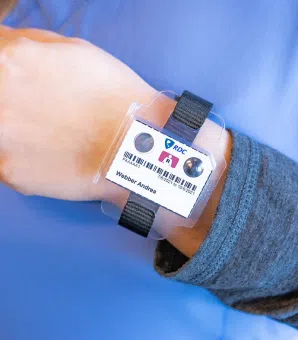
Dosimeter badge services for medical, dental, and veterinary businesses
Learn how Radiation Detection Company’s easy-to-use dosimetry solutions can boost the efficiency of your practice.
If you have employees that work with - or are exposed to - radiation, it’s essential to monitor their radiation exposure levels to minimize health risks. One effective way to do this is by using a personal radiation detector (PRD).
Equipping each of your employees who has the potential to be exposed to radiation with a radiation dosimeter will help monitor their exposure and minimize health risks. There are several types of PRDs on the market with many of them being representative of the field you are using them in and meeting the regulatory requirement. Choosing the right personal radiation detector requires careful consideration of several important factors.
In this article we’ll explore what some factors to consider (such as sensitivity, accuracy, and compliance requirements) when choosing the best dosimeter to meet your employees needs.
We hope that you find this article informative, and as always, we look forward to hearing your feedback!
Radiation protection is crucial to those working in environments where ionizing radiation is present (these workers are known as occupational radiation workers). Minimizing radiation exposure is vital to the safety of these workers. For this reason, the US Nuclear Regulatory Commission (NRC) established a body dose limit for occupational exposure for people working with radioactive material or ionizing radiation (for example x-ray imaging equipment) over a defined monitoring period.
There are five types of ionizing radiation: alpha radiation, beta radiation, neutrons radiation, gamma radiation, electromagnetic radiation (think x-rays). The dose limit functions as an extremely important form of protection for radiation monitoring in the workplace.
If you’re unclear on certain safety issues, in many cases your organization will have a radiation safety program, and you can work with your radiation safety office to ensure you are doing everything you can to minimize employee exposure to radiation.
Generally, those in contact with radioactive substances during the regular course of their employment (or those who have the potential to be exposed to radiation), carry personal radiation detectors or dosimeters. These dosimeters are specifically designed to record and indicate a measure of the accumulated dose absorbed. Dosimeters measure occupational dose, which is the dose received by an individual in the course of their employment where their assigned duties involve potential exposure to radiation.

Personal dose equivalent is a measure of the biological damage to living tissue as a result of exposure to radiation. Also known as the ”biological dose,” dose equivalent is calculated as the product of the absorbed dose in tissue multiplied by a quality factor, and then sometimes multiplied by other necessary modifying factors at the specific location.
Sensitivity is of the utmost importance when it comes to choosing the right personal radiation detector for a given situation. There are different types of radiation badges available depending on the radiation energies your workplace is exposed to. Each type of badge has its own sensitivity range and detection capabilities, which we will discuss further below.
Accuracy is another crucial factor when it comes to deciding which dosimeter is best for an occupational radiation worker. The detectors ability to accurately measure and record exposure to radiation is paramount to safeguard the health of your personnel.
Dosimeter fade and lower limit of detection (LLD) should be considered when researching the appropriate radiation badge for your practice.
Fade is the phenomenon of losing signal after the irradiation took place. This is important because a participant could receive a great amount of dose in the beginning of the wear period and by the time the wear period ends a great deal of signal is lost and occupational dose get underreported.
Dosimeter lower limit of detection plays an important role in deciding if it is suitable for your needs. When you are considering the LLD of different dosimeters you need to consider if the amount listed by the process is relevant for the wear period that you are trying to use, because lower limit of detection is a function of wear date. For example, an LLD of 1 mrem might be suitable for 1 day wear period or freshly annealed dosimeters but not for a quarterly frequency.
TLDs offer a significant improvement over older film badges in terms of accuracy. They maintain their accuracy across a wide range of environmental conditions and can provide precise readings even at lower levels of radiation exposure.
OSL dosimeters offer another high level of accuracy. They are extremely precise across a broad spectrum of radiation types and levels, which makes them ideal for monitoring even minimal exposure to a radiation source.
Radiation monitoring requirements are dependent upon federal and state regulations. It’s important to research what is required of your organization in order to maintain a compliant radiation dosimetry program.
A range of considerations should be the type of radiation energy exposure in your workplace, the wear period frequency for dose reporting, the type of radiation badge and calculation needed for accuracy and using an NVLAP accredited dosimetry service provider to stay in compliance.
To find out your compliance needs you can refer to your radiation safety officer (RSO), your equipment licensing, and your state regulators.

In addition to deciding what type of personal radiation detector is best, there are also multiple options for their placement. How employees should wear a personal radiation detector depends on the nature of their work responsibilities, and how they come into contact with radiation.
A ring dosimeter is worn on the finger and is ideal for employees who handle radioactive materials directly, as it can closely monitor the amount of radiation exposure to the hands.
The TLD-XBG Extremity ring badge is available for radiation workers whose job functions potentially require their arms, legs, hands, feet, fingers, and toes to receive a higher exposure.
Benefit: Ring badges can be used by veterinarians taking x-rays – i.e. having to hold the animal down during the exam. These dosimeters accurately assess the personal dose equivalent at the site where it’s worn.
Wrist dosimeters - worn similarly to a watch - are useful for those working in environments where they may be exposed to gamma radiation. The wrist badge is a good choice for workers whose arms may receive a higher exposure.
The Standard Type 82 TLD-XBG badge or Type 83 TLD-XBGN badge for neutron is fitted with a Velcro strap to be worn around the wrist. The wrist badge is available for radiation workers whose arms may receive a higher exposure, used due to dexterity issues, or even safety reasons.
Benefit: Wrist badges are an alternative to ring badges, specifically in nuclear medicine where the dose distribution is different on various parts of the hand.

Whole body badges are worn on the torso and provide a general assessment of radiation exposure to the entire body. This is especially suitable for workers in nuclear facilities or industries where full body exposure is possible.
The Standard Type 82 TLD-XBG badge or Type 83 TLD-XBGN badge for neutrons are used to monitor occupational exposure to a single individual working with radioactive materials. “Whole body” is considered to be the head, torso, arms (above the elbow), or legs (above the knee).
Benefit: TLD whole body dosimeters have been a trusted technology for decades and are still highly efficient and widely used today.
Similar to whole body TLD badges, OSL badges are generally worn on the collar, waist, or torso, with the label facing the source of the radiation. The standard OSL badge (or Type 84 badge for photon monitoring) is a 2-element beryllium oxide (BeO) badge with a minimum reportable dose of 10 mrem (0.10 mSv), and a LLD of 1 mrem. These badges are used to monitor occupational exposure to a single individual working with radioactive materials to ensure the dose received remains within the allowable dose limits.
Benefit: A major benefit of OSL dosimeters is that they provide for the possibility of repeated readout. This means that OSL dosimeters are often archived for multiple years, and then can be re-read, as the dose does not fade. OSL dosimeters can also be read with only light (unlike a TLD dosimeter which must be heated), which helps simplify the design. Their low dose rate sensitivity is also a benefit. Finally, OSL dosimeters are not impacted by heat or water.

These are specialized dosimeters designed for pregnant workers who work with or around radiation. They help ensure the safety of both the declared pregnant worker and the unborn child by carefully monitoring any exposure to radiation.
The Standard Type 82 TLD-XBG badge or Type 83 TLD-XBGN badge for neutron should be worn close to the embryo/fetus to obtain the most accurate dose.
Benefit: Fetal Monitors are available for pregnant radiation workers to ensure the fetus does not exceed 500 mrem for the entire gestational period or exceed 50 mrem in a single month.
Radiation Detection Company has 75 years of experience providing quality dosimetry service to over 28,000 companies across the United States. Still unsure of which types of personal dosimeters your organization needs? Please contact us, and our team will be happy to provide guidance.
Need a question answered that we did not address in this article? Please reach out to our Customer Care team, and one of our specialists will be more than happy to help.
Learn how Radiation Detection Company’s easy-to-use dosimetry solutions can boost the efficiency of your practice.
